Are you finding your first night far too taxing to be enjoyable? No? Well you are lucky. I was so panic stricken before my first night that I ate nothing all day! But then again I thought I had two left feet. Three years on I know that I am not one of these natural dancers but by sheer effort and determination I am as good as most, probably lacking some style, but I enjoy it!
Now what do you have problems with?
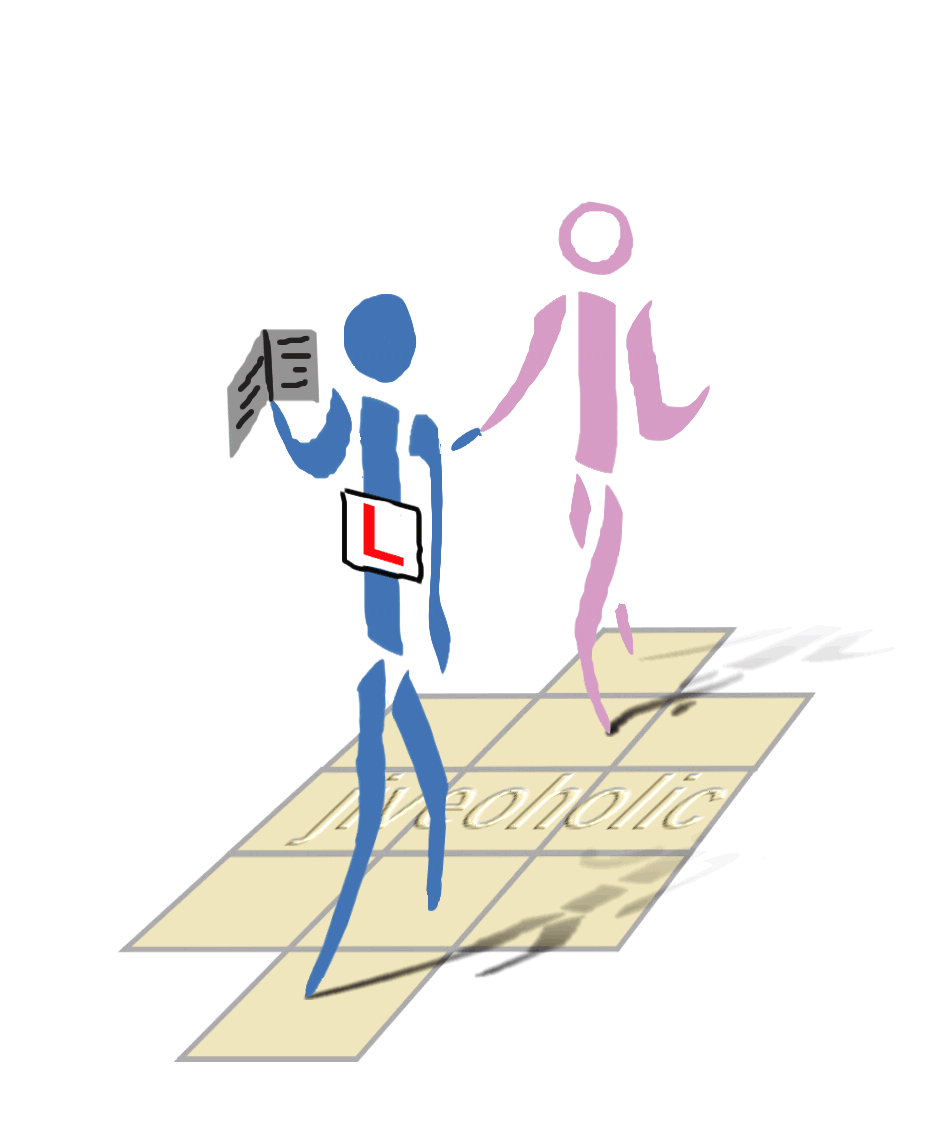
Strictly speaking there are no defined beginner moves. Different organisations have a different selection. However the organisation "Ceroc" was the first to list their versions and other have generally kept to the same ones. Typically there are less than 20 beginner moves and these and only these are taught in the beginner's lesson. After attending a few weeks one should become familiar with these moves. A list of beginner moves can be found by clicking under "Moves". Many of the intermediate moves are just variations or combinations of beginner moves. However, when progressing to intermediate moves, there are also some quite new moves and concepts that are introduced. A list of some examples of these (not necessarily complete) can also be found under "Moves". The important thing is not to get too hung up as to whether a move is a beginner move or not or that you have mastered absolutely all of them, but to slowly expand your repertoire.
I did. Now - no joke - I went home and practiced with a piece of string and a door knob! Waltzes are better practiced using a chair. I realised soon that this step back, step in thing was an important part to finding a rhythm with your partner.
The first important thing to discover is that jive "counts" are equal to two music "beats".
I remember being given lessons in the USA in a form of Country and Western dancing called "four beat swing". This is actually very similar to modern jive. They got us all partnered up with feet together holding man's left to lady's right and on count 1 we had to step back and put weight on our left foot (ladies: mirror with throughout, eg right foot back), then on count "&" put weight back on our right and then move the left foot forward in front of the right and on count 2 put weight on this foot and then on count "&" put weight back onto our right (thus the right stays put and the left moves. This was repeated - back and forth and back and forth - 1&2&1&2&. The arms were changing from neutral to tension (count 1) to neutral (&) to compression (count 2) to neutral (&). This can be practiced with a wall (clean your hands first!). Further information about this exercise is given here.
It is important to remember that one can (and should while you are learning) just step through each move. Its much easier this way. It is important that your arms take up and control this tension and compression. Under tension do not allow your arm to stretch completely. Everybody is different but my arms are somewhere between a right angle and straight. Letting them go straight gives a very jerky movement and you tend to lean back with curved back suddenly looking quite un-cool! When you come together, you should both end up with your hands roughly between you with right angled elbows. If (in particular the lady) allows her hands to get too near her body then the man has got no control over her - she feels like a limp lettuce! Back to feet - it is better to just step through the moves at first. Later on you can do "kick-ball changes" and other forms of little kicks, but then you are able to can fit these in naturally with the jive steps.
This is a typical question from those who have had lessons in more traditional dances. The answer many jive organisations give is "it doesn't matter", "whatever feels comfortable". I agree with the sentiment of this as the feet will come naturally with time and the important thing is to get enjoying dancing with minimum effort as fast as possible.
However, from observation, there are two ends of the spectrum: those who step on each half-count and those who step more slowly on each count. Then there are those who do a combination.
Secondly, if you are the one that is turning (usually the lady), then it more helpful to turn anticlockwise on the left foot and clockwise on the right.
As the men hardly spin (just half a turn), they can get away with stepping from one foot to the other on each half-count which helps them keep the beat (important). For the ladies it is more of a problem which is discussed more in "tips for improvers". Initially it is not a bad idea to take the easy approach which is just to try whatever flows nicely, concentrating on enjoyment and following. However sooner or later, some consideration may pay dividends (like learning to type).
At the beginner stage, there are two suggestions that you may wish to follow:
Getting a distinction between the turn and step-back gives a nice crisp feel to the move. What are the men doing? It is important that they step in and out and look lively!
When one dances a waltz ie 3/4 time (three quarter-beats in a bar) then it is important that one synchronises to each bar. Modern jive does not. Indeed the wurlitzer is 4 counts (8 beats) long, the hatchback 3, the first move, 7 etc. It seems to make no difference on quite which beat in the bar one starts a move. That makes it simple!
Even more sophisticated modern dances like Lindy Hop has 6 and 8 beat moves. The 6 beat moves can start in the middle or at the start of a bar, whilst, admittedly, the 8 beat ones are synchronised to start at the beginning.
Back to jive - what is nice, is to be able to finish a move on what is know as a break, or a stop in the music. This takes some practice and is often fiddled by dynamically altering the length of a move to coincide!
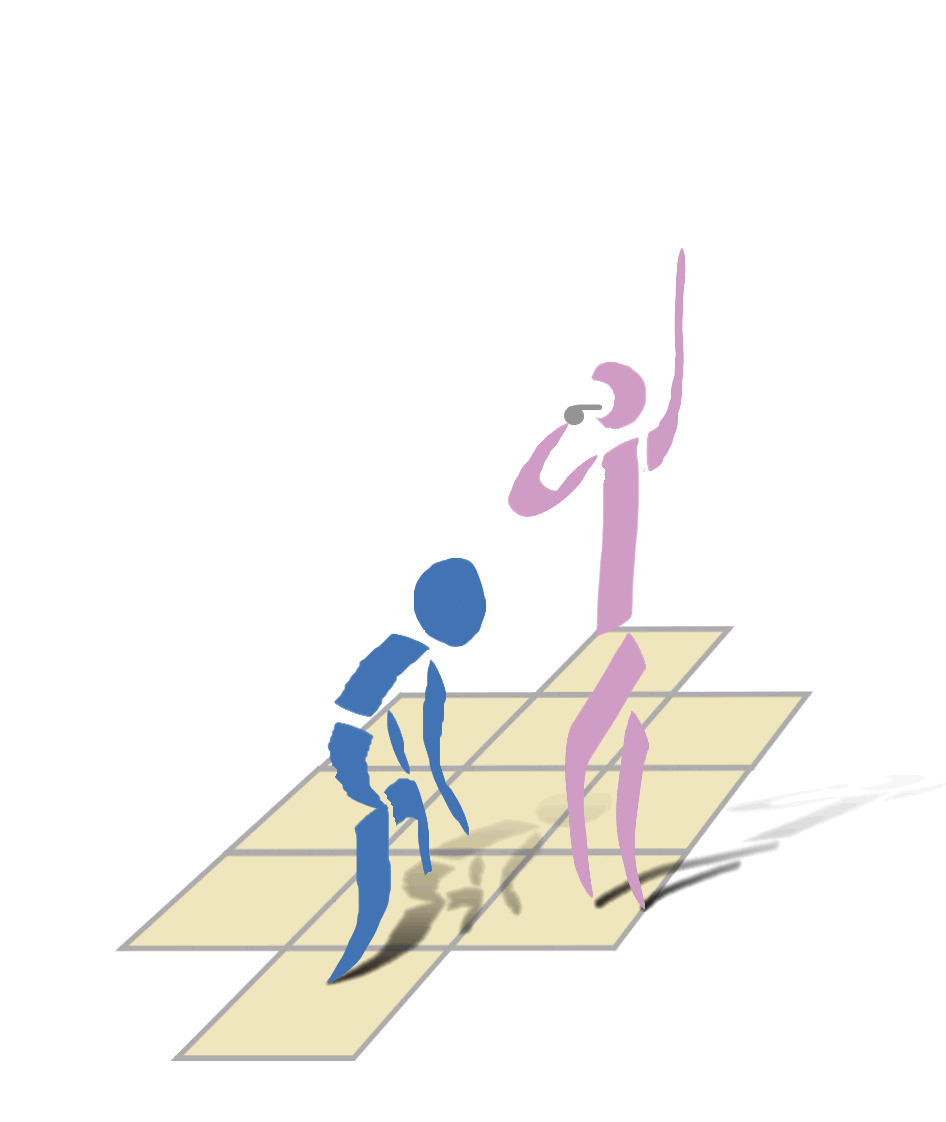
The usual way that jive is counted in during lessons is 5, 6, 7, 8 &, 1......
Each count is two music beats (unlike Lindy Hop where one counts music beats). Start moving as the count is being called to find the rhythm. You should be close together. If a simple push is used, then this is given on the & and you should be stationary under tension on the 1 of the next bar. Some organisations used a half circle to indicate a start and this occurs on the 8, followed by the push on the & and tension on the 1. The semi-circle is to the left when using the left hand and to the right when using the right.You will not at first. It is easier just to repeat the 4 or so moves you learned in the lesson. Tell ladies that you are a beginner and they will nurture you as they need more men desperately! Ladies will usually know that you are a beginner as it seems nearly impossible for beginners not to grip on for dear life! Yes, ladies like variety, but most of all they like good rhythm and confidence more. You can always ask for assistance. A lot of ladies are reticent to offer any or too much help as us men often show signs of irritation when helped. Hopefully you are not one of these. It is very difficult for a lady to teach a man new steps by dragging him round the floor. He needs to get the moves into his brain first and not learn to follow!. If you are a lady, though, you will have noticed men slipping in all sorts of moves without you knowing or they can explain the move as they twist you into position. This cannot be done to men as they will then start to learn to follow.
Sometimes I get a bit fed up with my repertoire of moves and have been known to dance with an imaginary partner at home just mentally going through the moves. Its good for rhythm and keeps you fit, you do not need a partner and you do not get trod on! I remember once at Christmas, swapping roles, the ladies had to learn to lead 4 moves and the men follow. Even the good ladies were asking me to call out the next move because they just could not think of them in time!
I used to think that certain moves were essential for changing from a left to right hand grip to a right to right such as one ending in a spin. Whilst this is a nice smooth way of doing it, it is quite permissible to do a move that ends in one hand-grip and quickly change hand once she had turned and it is at waist level. Additionally, we all have our "fill in" moves when we are thinking of what to do next (or the next lady we are going to dance with!). For me it is the man-spin. One lady once joked that I ought to write some moves in my T shirt. I now have one with 30 moves listed under headings like "cool as a cat", "slow and sexy", "drop and trust", etc. The idea was that the lady could call out a favoured move. It was fun but useless when the lights went down!
We all do. With my confidence of 3 years jiving, I now say "woops - lost the rhythm", stop in my tracks, count loud 5,6,7,8 and start again! That is perhaps a bit drastic and only needed for some particular un-danceable syncopated music. Usually I return to some move that I do know well with nice arm movements to get into the swing.
At this point I shall digress into one disadvantage with jive. As there are few rules concerning the feet and body position, each person finds his or her own rhythm. I have found that there are "boppers", and "wigglers". I am a bopper. My right leg stays always bent a little and, when I step back, I extend my left foot to be straight (on count 1) and my head going higher ever so slightly, then relax into my right leg which bends slightly (on count 2), lowering my head slightly and then step forward and straighten my left on four, raising my head. This is rather similar to Cajun dancing - "jive with a limp"! You can't see me go up and down, but I feel the movement. Many ladies do something similar. Other ladies wiggle! They either wiggle left right or twist to the left and to the right. I have to admit that when I bop and she wiggles, the outcome is less than perfect, but still quite presentable. I tend to find that I start changing to the style of the lady. This is deliberate. Firstly, I feel that as I lead all the moves, the least I can do is to allow her to dictate the body movement. Secondly, I think that they usually have a better sense of "wiggle" and its fun to learn a new style.
I do find that one in a hundred ladies are impossible to dance with. One dance with a thank you is quite enough. They know it and I know it, that we were cr#p! In these circumstances I often get the feeling that the lady is leading me too early. Perhaps she is bopping down when I am bopping up? I really don't know. What I do know is that this happens when I try with some good experienced dancers.
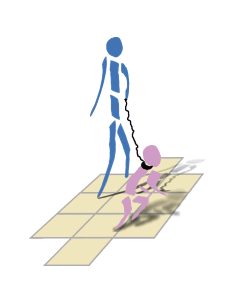
This comes with practice and listening at lessons. It also comes from thinking about the lady before the next move. You would use an indicator before turning right in a car - well, it's the same here. If I think that the lady is unlikely to understand a lead for the next move, I will call it out eg "windmill"! Many ladies like that one called out as it is difficult to differentiate from the catapult.
Some generally useful tips are as follows. Keep the hands low at waist level most of the time (this always seems SO difficult but it looks cooler this way). When you raise a hand it signifies either a spin or a turn. The former is indicated usually by pressing palm to palm (ie not holding on - even lightly) meaning a preparation to lose contact. The latter involves no change other than raising the arm, ie loose fingers round each other grip. The only exception seems to be the Yoyo, where a palm to palm is used for both. The other important difference is that the man pushes upwards and round for a turn and downwards for a spin. It is important for the lady to offer resistance as a man leads her and not go all floppy. This allows him to quickly control the position of her body. A ball-socket grip is often used for a spin after a block, ie the man has just moved the lady's hand out to the right and he forms his hands like a socket around the lady who forms a ball to spin her to the left.
Many moves have special leads. The archi-spin has a gentle finger or palm squeeze, the hip-hop a tap on the left shoulder etc. However I think ladies must follow from intuition too! Well, I just don't know how they do it. It is always more difficult to lead a lady at a different venue as they often have a different dialect of moves. I remember going to Fleet once and on two occasions lost my ladies half way through the basic side to side. It would appear that they taught a slightly different move ending in a spin. Once I worked this out, I held on firmly! Some ladies like a firm lead, others prefer a lighter touch (but need to be more experienced).
This may be obvious, but remember that you cannot lead with a claw-tight grip! Normal leading is about placement of the hand, so all thumbs should be kept well away from one-another! Ladies - a man cannot lead a person with a floppy arm. He wants to lead your body through your arm. Allow your arm to raise up and down effortlessly but when he pushes or pulls, allow your body to be turned.
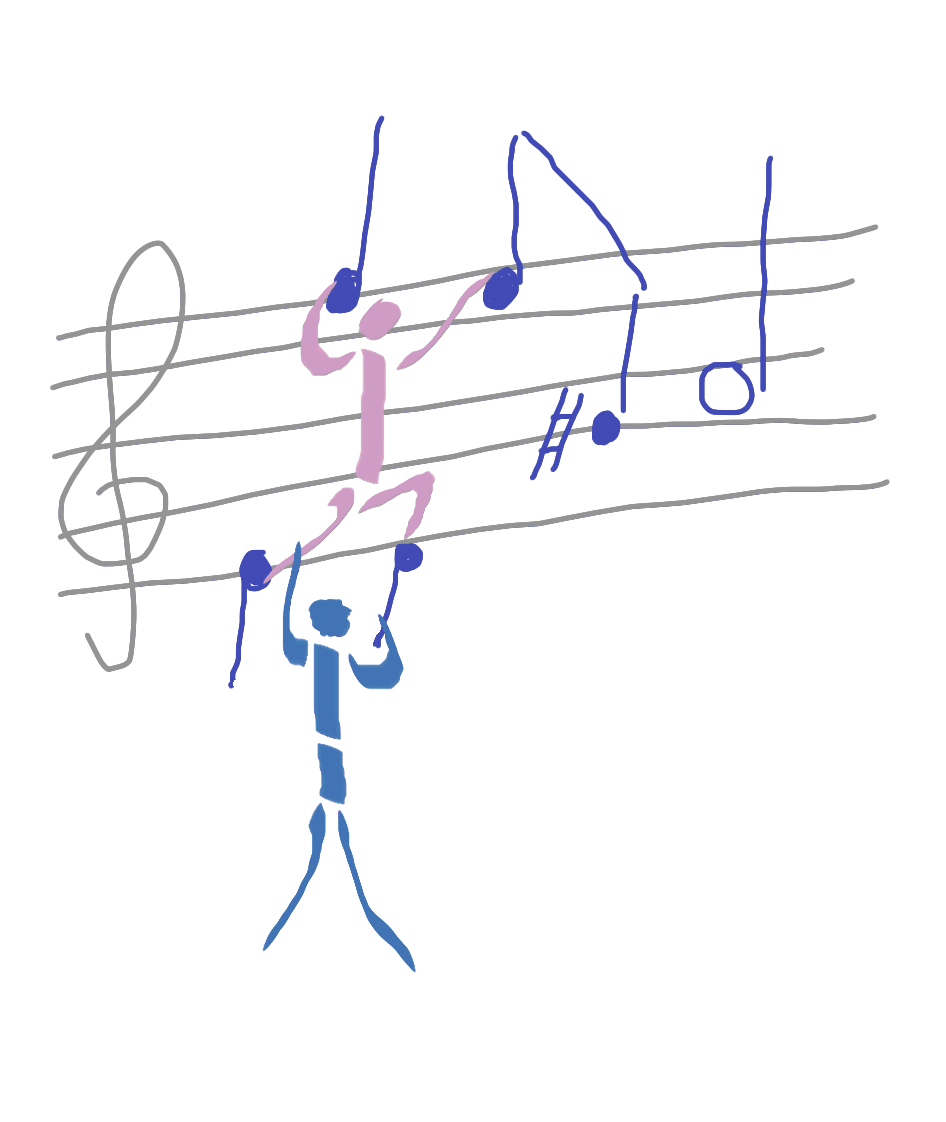
I think that I am the last person to suggest anything on this! I keep going to special classes and find it impossible. My own theory is that jive is not the best dance for interpretation as the moves are so quick, twirly and all have different number of beats in them. There are, however, a few things one can do.
Firstly, smooth music needs smooth twirly moves or slow combs whilst "jerky" music suits breaking the lady's move in one direction and changing to another (called a "break").
Secondly, there are things called "breaks" in music, where it suddenly stops. Its really cool to stop exactly where you are - even in the middle of a complex 13 stage archi-reverse-cross-over with double basket on the end. Even better if you can use a move that ends with something cool, like a drop. I find the latter only works by fluke not design - I just do not know the music well enough.
The final thing one can do is to use one's whole body more. Perhaps find a jumpy rhythm or swing hands out for slow music. Perhaps look at your partner more seductively at critical stages or sultry. Use your shoulder more, make a gesture with your spare hand, consider how you form you body (eg ballet pose), consider the exact placement of you feet etc. The beauty of jive is that there are no rules and the dance is an excellent framework for your own interpretation.
No! - not yet. You will find a way of dancing that may not be conventional. It could well work well, but will not be jive and not help you dance well with others. I sometimes see couples arrive at their first evening and are reticent at losing each other and rotating. It is the best thing for them as together, neither knows what they are doing, apart there is a good chance that one gets a better partner.
I feel strongly that jive is about dancing with lots of others, not being brilliant with one person. As you move around, you will discover what is "common" to the dance, and what peculiarities some dancers have. Find yourself the best dancer there and ask them for a dance, explaining that you are keen to learn and improve. You will then get a better "feel" of what is right and wrong and will know if you are doing it well with your partner.
Do you make notes? No? Sorry - then I have no sympathy! This is mainly for the men. The ladies are at the mercy of the man and they need to learn to follow. The only way they can learn is by doing it and discovering the myriads of different way of getting from one bodily contortion to the next. After a while they seem to learn to recognise a pattern. As for the men, it is important that you practice the moves from that night at that night. Obvious? Yes - but few do it. You then need to remind yourself for a few minutes just before going out the next night. However, you will find moves that you like and ones that you do not - drop these - at least until you are taught again, when they may seem easier and more enjoyable.
Ladies (who have expressed an opinion) get pleasure from two main things (dancing that is!) i) feeling the rhythm and making the dance a "personal experience" and ii) a variety of moves. When asked to choose between these, nearly all say the former! Thus they prefer a few moves performed well to lots of moves performed badly. So concentrate on the few moves you can do well, with confidence, looking (yes looking) at the lady at strategic moments and use the music to express yourself!
One way to remember new moves is to link them to previous moves. Let us assume you can remember most of the beginner's moves. Link say the first move with a more complicated arm-jive move. Alternatively link it to a more complicated first move, but I do not suggest you have two first moves, albeit different, following each other.
This is understandable, especially as the count used by some teachers is kept simple. Some might benefit from something more exact. Let us consider the normal teaching for the hatchback - however all the moves are similar. Often the count is given as follows:
| Count | Description |
|---|---|
| 1 | Step back |
| 2 | Step in with lady's arm to man's left shoulder |
| 3 | Spin the lady |
| 4 | Catch |
Let us now consider things a little more accurately, ie the half count
| Count | State | Description |
|---|---|---|
| & | Moving | Start stepping back |
| 1 | Stationary under tension | Stepped back |
| & | Moving | Start stepping in |
| 2 | Stationary under compression | Lady's hand at man's left shoulder |
| & | Moving | Start spinning lady |
| 3 | Moving | Hand loses contact and you turn yourself |
| & | Moving | Catch her hand and step back |
| 4 | Stationary under tension | Stepped back |
So you see that there are three points during this move, actually on counts 1, 2 and 4, when you are under tension/compression - certainly not moving. The lady is spun, actually on a half beat (often not taught). Most of the time the actual timing comes naturally and such considerations might be considered rather dry, but for those amongst us who get easily confused (probably from thinking too much), such an analytical approach can be of value.
Firstly, the modern jive hand-grip is extremely loose.
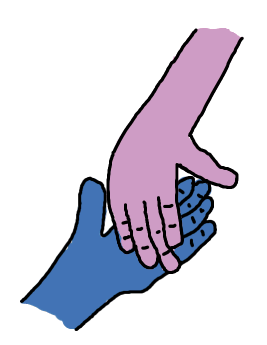
The man offers an open palm, facing upwards. The lady drapes her hand over this palm. BOTH KEEP YOUR THUMBS TO YOURSELF! There is no reason to use the your thumb to hang on with. Beginners can often be recognised before the dance has even started by a vice-like grip (as well as the look of terror in their eyes!). When you need to keep the tension between you as you step apart, bend your fingers to keep hold. (There is only one move - the archi-spin - where you will be told to use your thumb, as a signal).
Secondly, when a man turns a lady, he should initiate the turn with a bit of a push, but then just hold her hand over her head. When using the right hand it is best if he just holds his hand, palm down, without holding on at all. The lady then presses a few fingers upwards into his cupped hand. This is more difficult with the left and indeed I tend not to do it. Try very much to avoid "winding the lady" through the turn like winding up a clockwork toy!
Whilst the man holds either palms upwards when he starts a turn, and it appears upside down and awkward after the turn, it is often beneficial to leave it like this if the next move is a reverse turn. This way it un-twists itself naturally.
It is important that the man LEADS the spins. To do this he needs to inject energy into the lady's spin. He cannot do this if her hand is as limp as a lettuce leaf!
All spins start by the lady pushing in the direction opposite to the spin! eg the arm-jive: she is pushing forward against he man in a palm to palm hold. In the wurlitzer, she has turned 90 CW before an ACW spin. In the lady-spin, she has been turned ACW 90 ready to go CW. The idea is that the lady allows her whole arm and parts of her body to go rigid so that she and he can push against each other to propel her round. This way the man will feel a definite resistance (which feels great). The lady will feel that the man is leading her (which also feels great).
Firstly, modern jive is not choreographed, except for some competitions. Most men do not think more than one move ahead! So what move should come next?
Another introductory point, that becomes obvious, is that, when joining moves, the step back at the end of one move IS THE VERY SAME step back starting the next move, ie one does not step back twice!
When I was a beginner (frightens me to think about it!), I could see that, in general, moves could end with 3 hand holds, L-R, R-R and double. They also could start with a L-R and R-R (the double hand hold really starting with a L-R and quickly grabbing her other hand). I therefore assumed that one could only continue say a move that started with one hand-hold if the previous move ended with that hand-hold. This gave me far too much to think about.
Then I learned about moves which ended with a spin. It might seem obvious now, but when the lady spins (rather than turns), one lets go. The result is that you can catch her in any hand hold you wish! I therefore started using simple spins to connect moves together if I needed to change the hand hold. For example: after a basic yoyo (ending R-R), one can put in say a lady spin (starting with R-R) and then catch L-R for a first move. Alternatively you can use a yoyo push spin.
After this I discovered that you could cheat. When returning a lady anticlockwise 360 with say a R-R hand hold, one could smartly transfer her right hand from my right into my left. Some teachers suggest that it is best this is performed at waist level, just as she has spun but not yet stepped back. Changing hands over her head can look awkward for just a single return (although changing the hand and then turning her for a second turn can look OK). It can take some dexterity to ensure that the flow is smooth.
Another useful rule promoted by Leroc is (simplified a little) that you try not to perform two consecutive spins/turns in the same direction. Thus after an arm-jive ending with a turn (clockwise) and return (anticlockwise), it would be wrong to perform a basket or lady-spin which starts with an anticlockwise move (albeit only half a turn). It is suggested that one should eliminate the final return from the arm-jive. This also has an advantage that the lady's natural footwork is sometimes easier. In a similar vein and more commonly known, when performing a comb, the return before the actual comb should be the return from the previous move.
Finally, if you listen, the music often dictates the type of moves you wish to use. Perhaps you should be stringing together slow flowing moves, perhaps jumpy ones. When you get really good, and can hear that the music is going to stop suddenly, one can work towards some flash move so she is stunningly positioned at that exact time!
Great isn't it!